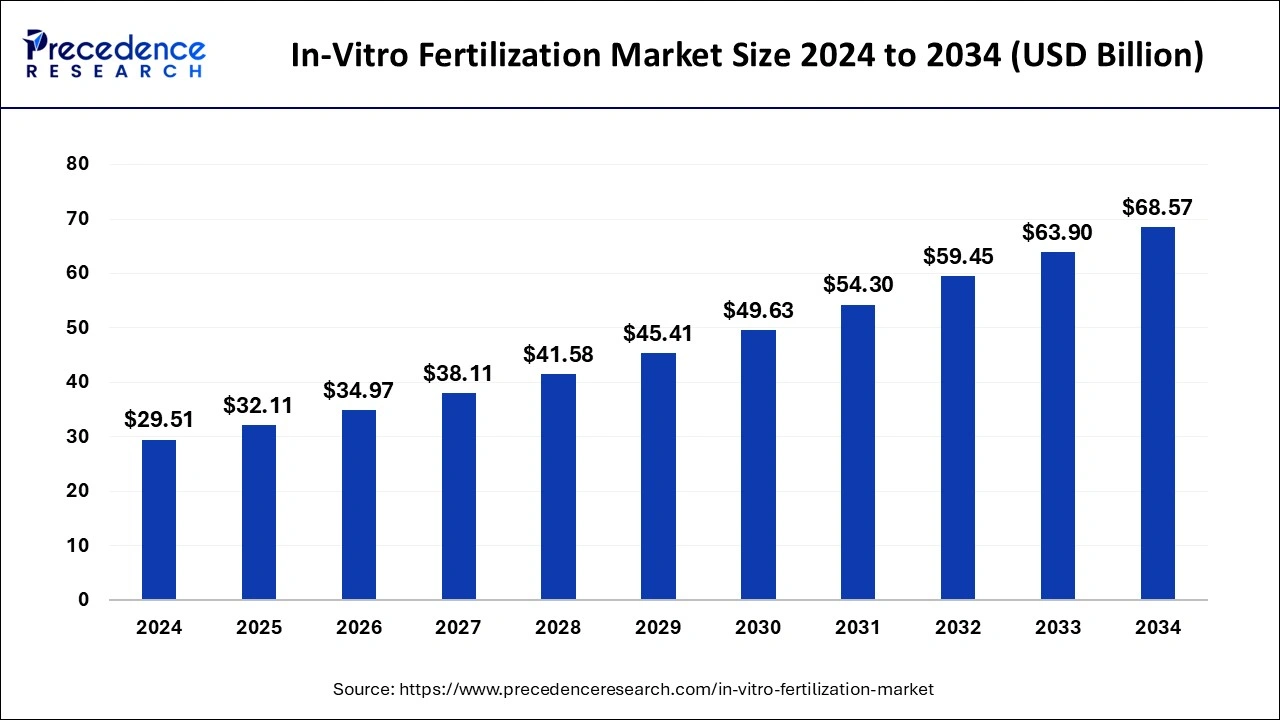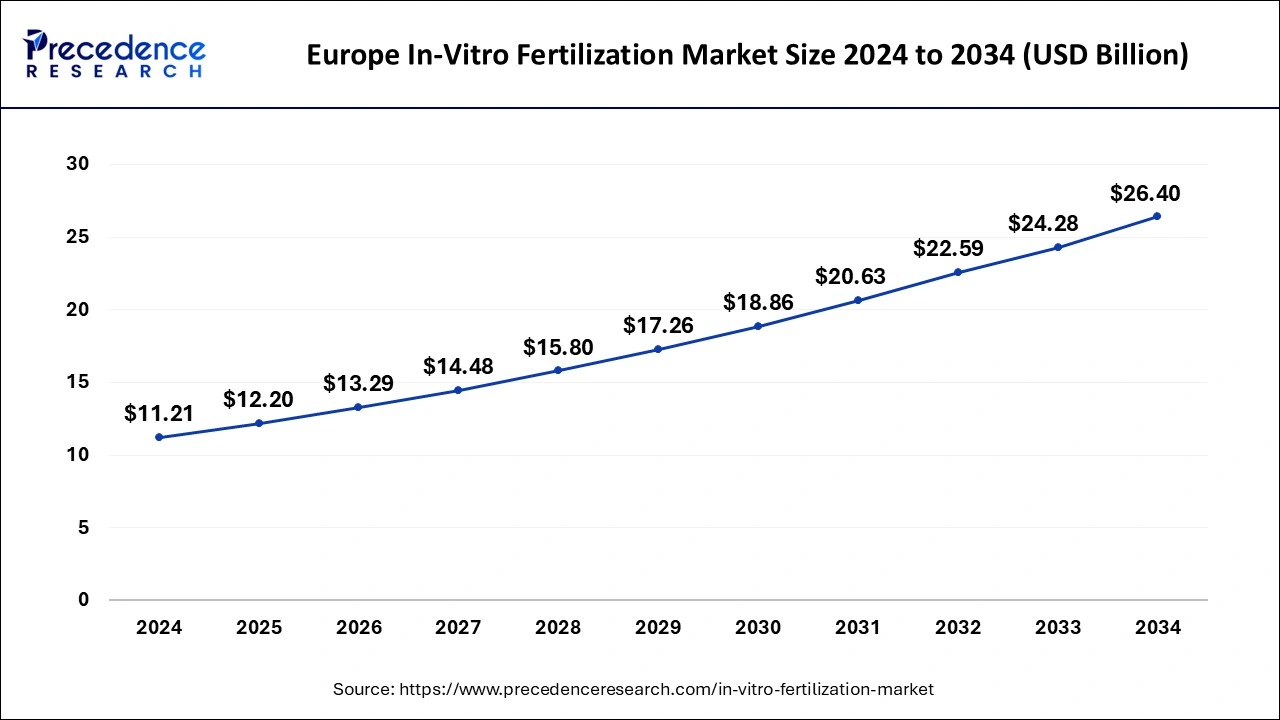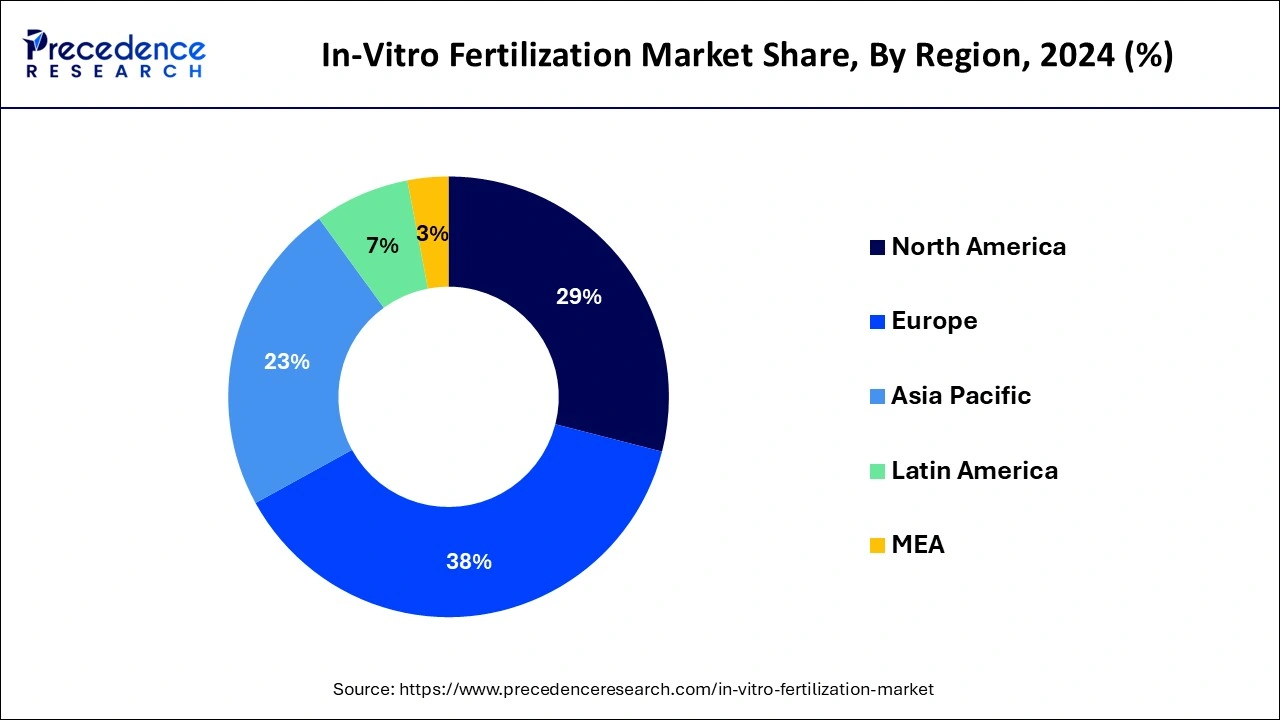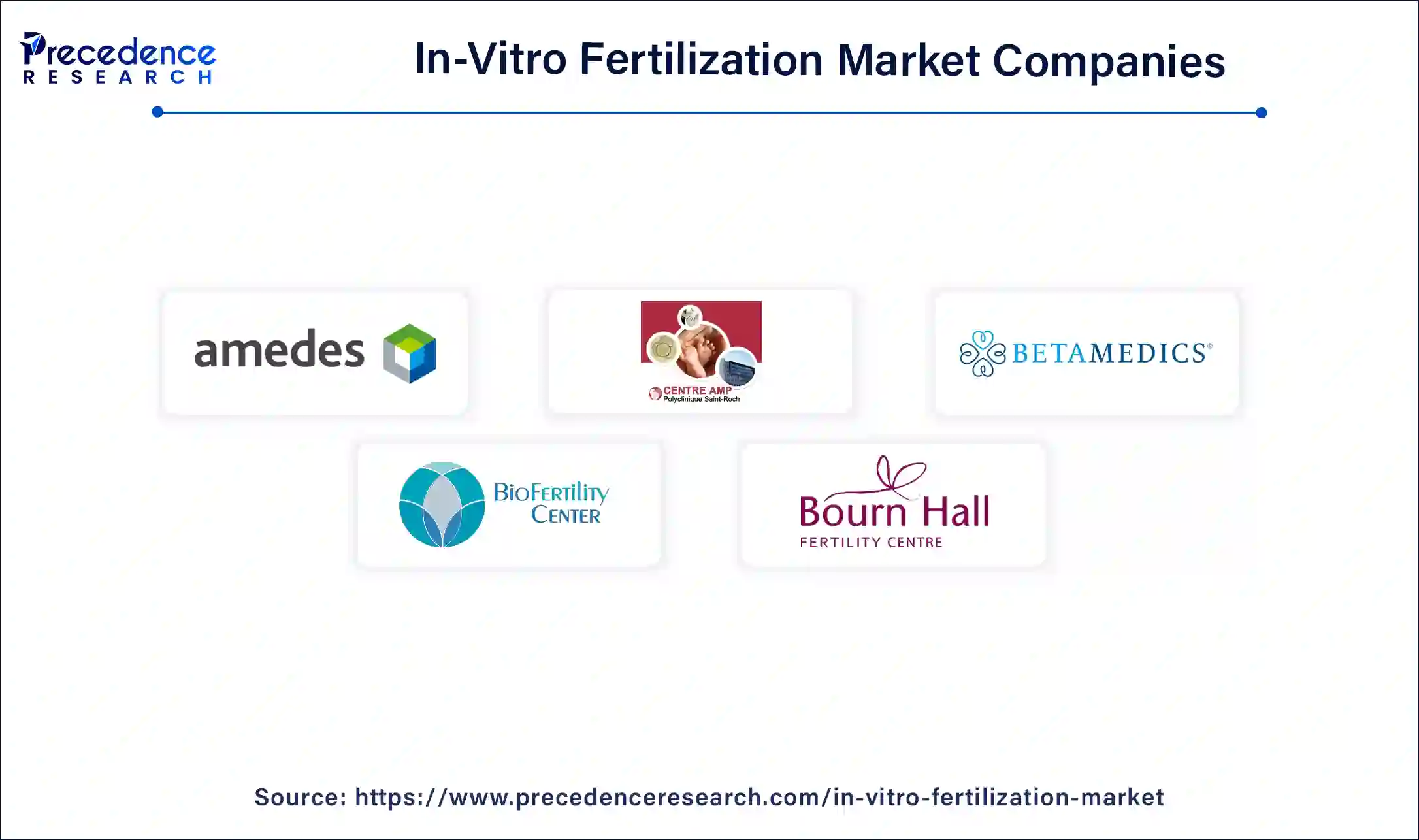What is the In-Vitro Fertilization Market Size?
The global in-vitro fertilization market size is calculated at USD 32.11 billion in 2025 and is predicted to increase from USD 34.97 billion in 2026 to approximately USD 68.57 billion by 2034, expanding at a CAGR of 8.80% from 2025 to 2034.

In-Vitro Fertilization Market Key Takeaways
- Europe dominated the global in-vitro fertilization market with the largest market share of 38% in 2024.
- Asia Pacific is projected to expand at the fastest CAGR during the forecast period.
- By procedure type, the frozen non-donor segment contributed the highest market share in 2024.
- By instruments, the culture media segment captured the biggest market share in 2024.
- By end user, the fertility clinics segment has held the largest market share in 2024.
A Booming Overview of the Global IVF Industry
The global in-vitro fertilization market is primarily driven by various factors such as rising male infertility, increasing median age of first-time mothers, increasing obesity, declining fertility rates, and growing consumption of alcohol. Moreover, the rising awareness regarding infertility, coupled with the availability of advanced treatment options, is fuelling the demand for in-vitro fertilization.
AI: The New Precision in IVF
Artificial intelligence is bringing a wave of change to in vitro fertilization, making it more precise, with higher eventualities of success and efficiency. An algorithm acting on AI converts data, both from images and biological sources, to select embryos with the maximum possible potential for implantation, excluding chance, if not pure trial-and-error procedures. It customizes treatment regimens by amalgamating hundreds of parameters from medical histories, hormone levels, and lifestyle factors. AI, meanwhile, rids repetitive activities and lays down standardized operational protocols to deliver increased consistency and the resultant slight errors. Predictive analysis aids physicians in diagnosing complications early and adjusting treatment protocols accordingly. Innovation is, thus, expedited for a future that is reliable, effective, and patient-centered within the ambit of IVF treatments.
In-Vitro Fertilization Market Growth Factors
The global in-vitro fertilization market is primarily driven by various factors such as rising male infertility, increasing in the median age of first time mothers, increasing obesity, declining fertility rates, and growing consumption of alcohol. Moreover, the rising awareness regarding the infertility coupled with the availability of advanced treatment options is fueling the demand for the in-vitro fertilization. The rising median age of the first time mothers is a significant growth driver. This is attributed to the rising number of women population prioritizing their education, work, and career. This results in late marriages. Moreover, the increased awareness regarding the contraceptives and its rising usage is another factor behind the increasing median age of the first time mothers. According to the Australian Institute of Health and Welfare, the median age of the first time mothers in Australia grew from 27.9 years to 31.9 years from 2009 to 2019. Therefore, the increasing average age of the first time mothers is one of the most significant factors that is estimated to propel the growth of the in-vitro fertilization market during the forecast period.
Delayed pregnancy after marriage is another crucial factor that drives the market growth. There has been a surge in the number of mothers who delays pregnancy even after the age of 35 years. The delayed pregnancies leads to complications in pregnancy, which gives rise to infertility and hence it drives the in-vitro market growth. Furthermore, the decline in fertility rates across the globe is contributing significantly to the growth of the market. According to the United Nations World Fertility Report 2019, a rapid decline in the fertility rate have been observed in around 77 countries across the globe. It was observed that the adolescent fertility rate decreased by over 50% between 1990 to 1995 and 2015 to 2020. As per the Hebrew University of Jerusalem, the sperm count in men have declined more than 50% in the last 40 years. Therefore, the rapidly declining fertility rates are the top contributors to the growth of the global in-vitro fertilization market.
- A steady rise in the incidence of male infertility is causing a growing demand for ART.
- The growing median age of first-time mothers is due to lifestyle modifications and career priority-induced upward push into IVF treatments.
- The increased trend of delayed pregnancies has increased infertility risks and, consequently, should demand for IVF answers.
- Declining fertility rates with other populations are proving to grow market opportunities significantly.
- Growing awareness of infertility and availability of advanced treatment options have almost led IVF to universal acceptance.
- Rising infertility rates: The combination of factors such as stress, pollution, hormonal imbalance, and change in lifestyle is responsible for the rise of male and female infertility, which in turn is a major contributor to the demand for IVF.
- Delayed parenthood trends: Couples who are more concerned with their professional career and personal goals are the ones to experience a postponement of marriage and childbirth, which then results in age-related fertility problems and infertility treatment cycles.
- Declining fertility rates: The world has already seen a huge drop in the number of sperm and in the rates of natural conception, which has drastically increased the need for IVF technology.
- Technological advancements: Technologies like cryopreservation, time-lapse embryo imaging, and better culture media are making the process of IVF more successful as well as more accessible.
- Growing awareness and acceptance: The awareness campaigns that are becoming more common, the regulations that are getting more favorable, and the stigma that is shrinking surrounding infertility treatments are the factors behind the global embracement of IVF.
Market Outlook
- Industry Growth Overview: The rising median age of first-time mothers is a significant growth driver. This is attributed to the rising number of women in the population prioritizing their education, work, and career. This results in late marriages.
- Global Expansion: Europe and North America currently hold the largest market shares in terms of revenue, while the Asia-Pacific region is expected to be the fastest-growing market.
- Major investors: Major companies and investors in the market include large corporations like CooperSurgical, Merck, Vitrolife, and Fujifilm.
- Startup Ecosystem: The In-Vitro Fertilization (IVF) startup ecosystem is witnessing rapid growth, fuelled by technological innovations such as Artificial Intelligence (AI), advanced genetic testing, and telehealth platforms.
Market Scope
| Report Coverage | Details |
| Market Size in 2025 | USD 59.45 Billion |
| Market Size in 2026 | USD 34.97 Billion |
| Market Size by 2034 | USD 68.57 Billion |
| Growth Rate from 2025 to 2034 | CAGR of 9.10% |
| Largest Market | Europe |
| Base Year | 2025 |
| Forecast Period | 2025 to 2034 |
| Segments Covered | Product,End User, Region |
| Regions Covered | North America, Europe, Asia-Pacific, Latin America, and Middle East & Africa |
Value Cain Analysis
- R&D: New IVF systems are being invented to increase success rates; hence, we have AI to perform embryo assessment. Similarly, research can be zones for improvements in genetic screening and culture media.
Key Players: Illumina Inc., Thermo Fisher Scientific - Clinical Trials and Regulatory Approvals: At this stage, the new protocols, technologies, and drugs of IVF are converted to undergo human test of safety and efficacy testing, and the authorities enforce the issuance of licenses for their use.
Key Players: U.S. Food and Drug Administration, Boston IVF, and Nova IVF Fertility - Formulation and Final Dosage Preparation: In IVF, this refers to special media preparation for embryo culture and cryopreservation, and preparing hormonal medicines for ovarian stimulation, such as gonadotropins and GnRH-analogs.
Key Players: Merck KGaA, Fujifilm Irvine Scientific - Serialization and Packaging: Packing of specialized media, medicines, and other IVF products shall be undertaken, keeping in mind the regulations about labeling, serialization to ensure traceability, and authentication in the pharmaceutical supply chain.
Key Players: McKesson, Vitrolife, and CooperSurgical - Distribution to Hospitals, Pharmacies: It is the logistics of transporting packaged IVF products and medications from manufacturers to fertility clinics.
Key Players: FedEx and UPS
Product Type Insights
Based on the product type, the fresh non-donor segment dominated the market with revenue share in 2024. This is attributable to various factors such as high rate of success, higher birth rates as compared to that of frozen embryos, easy implantation, and the fresh embryo transfer results in better results. The higher adoption of the fresh non-donor cycle coupled with the rising infertility rates across the globe is the major driver of this segment. The increased popularity of this cycle is expected to sustain its dominance throughout the forecast period.
The frozen non-donor is expected to witness fastest growth segment during the forecast period. This is mainly attributed to the higher pregnancy rates along with the low cost. Frozen transfer is much easier for both the patients and the endocrinologists. Moreover, the level of stress on the physical and mental health of the women is less in the frozen non-donor cycle, which is expected of fuel the growth of this segment in the forthcoming years.
End User Insights
Based on the end user, the fertility clinics segment accounted largest revenue share in 2024. Fertility clinics are the first preference for the couples to diagnose their issues related with fertility. The fertility clinics are the specialized clinics that offers specialized care services to the couples and individuals related to their pregnancy and fertility problems. The increasing number of fertility clinics, increasing awareness regarding the fertility clinics, and declining fertility rates are the major factors that has fostered the growth of the fertility clinics segment across the globe.
Hospitals is estimated to be the most opportunistic segment during the forecast period. The wide spread penetration of the hospitals, developing healthcare infrastructure in developing nations, 24*7 presence of health professionals, and availability of advanced surgical tools and equipment in hospitals are the major factors that boosts the demand for the hospital services.
Regional Insights
Europe In-Vitro Fertilization Market Size and Growth 2025 to 2034
The Europe in-vitro fertilization market size was evaluated at USD 12.20 billion in 2025 and is predicted to be worth around USD 26.40 billion by 2034, rising at a CAGR of 8.94% from 2025 to 2034.

Europe dominated the global market with the largest market share of 38% in 2024. due to rising medical tourism and legal revisions related to IVF techniques.
Asia Pacific region is expected to witness remarkable CAGR during the forecast period. This is attributed to the presence of huge population, rapidly declining fertility rates, rising number of women focused government initiatives, growing preference for careers over family among women population, and increased awareness regarding the fertility clinics and procedures. The growing awareness among the population regarding the in-vitro fertilization, rising healthcare expenditure, and rising adoption of advanced reproductive technology in Asia Pacific are the prominent drivers of the in-vitro fertilization market. Furthermore, the rising medical tourism industry is anticipated to impact the growth of the in-vitro fertilization market in the region. The country like Japan and South Korea are facing declining rate of population owing to the rising median age of the first time mothers. Women in these countries are more concerned regarding their career and gives lesser importance over starting a family during their 20s. Therefore this results in delayed marriages and delayed pregnancies. Women over the age of 35 years have higher chances of miscarriage and stillbirth. Therefore, sometimes even after receiving the fertility treatment, the success rate is low due to the aging factor of the women. This factor may have negative impact on the market especially in countries like South Korea and Japan. Moreover, the population control policies of the Chinese government is expected to have a massive impact on the China in-vitro fertilization market.

North America is witnessing a significant decline in the fertility rates among both the men and women population. Moreover, the rising prevalence of polycystic ovary syndrome. The rising number of fertility clinics, improved reimbursement policies of the government pertaining to fertility issues, and increased healthcare expenditure are the major factors that drives the growth of the North America in-vitro fertilization market. Delayed marriage and pregnancy, rising obesity rates, and increased consumption of alcohol are the primary factors behind the surging infertility rates, which is expected to drive the North America in-vitro fertilization market.
How is Europe leading in the In-Vitro Fertilization Market?
The IVF market is dominated by Europe mainly due to the availability of fertility treatments on a large scale, the use of state-of-the-art reproductive technologies, and the presence of favorable legal frameworks. Along with rising infertility problems and public financial support for assisted reproductive techniques, the region is in a good place. High-success-rate treatments and the presence of well-established fertility clinics in countries such as Spain and Denmark are also contributing to Europe's dominance, which is further supported by continuous innovation and strong clinical expertise in reproductive medicine.
Spain and Denmark In-Vitro Fertilization Market Trends:
Spain and Denmark are ranked high among the European IVF markets because of their well-equipped fertility centers and the favorable reproductive laws. The large number of patients who can get treated through IVF is the result of combining high success rates of the treatment, the latest technologies, and the increase in people from abroad coming for fertility treatment. Besides, the policies are encouraging, the procedures are quick and easy, and there is a strong acceptance of IVF by the public in these countries, which leads to their dominance and makes them the preferred places for assisted reproductive care in the European fertility market.
How is Asia-Pacific performing in the In-Vitro Fertilization Market?
The Asia-Pacific region is the fastest-growing IVF market due to a number of factors such as decreasing fertility rates, increasing medical tourism, and greater understanding of infertility treatments. India's, China's, and Japan's contributions to the market are based on technological advancements, government support, and affordable treatment options. Urbanization, lifestyle shifts, and the trend of later marriages have created a larger demand for ART, which is the reason why the region is turning into a huge area for fertility care expansion.
India In-Vitro Fertilization Market Trends:
The rapid growth of India's IVF market is attributed to the increasing infertility rates, delayed marriages, and the influx of medical tourists. The usage of technology which is state-of-the-art technology, cost-effectiveness, and the availability of experienced professionals are the factors making it a favored place for fertility treatments. The government's active participation in providing support and conducting campaigns has made the services available to more people, while digital platforms are making patient engagement and treatment management stronger, thus establishing India's connections with Asia as the topmost fertility care provider.
What are the driving factors of the In-Vitro Fertilization Market in North America?
North America is still an important IVF market, and the main reasons behind this are state-of-the-art healthcare infrastructure, increasing infertility rates, and insurance coverage for fertility treatments that are becoming more widely available. The region is supported by a robust network of fertility clinics, utilizing the latest reproductive technologies, which fosters steady market growth. The society's general acceptance of assisted reproduction, along with the support of corporate fertility benefit programs, is also instrumental in making the whole process of seeking fertility solutions more accessible and affordable for couples.
United States In-Vitro Fertilization Market Trends:
The United States is the leading IVF market, where the rising infertility rates, excellent clinical infrastructure, and remarkable research progress are the three factors supporting its position. Insurers' gradually expanding mandates and employers' providing fertility benefits have made the treatments more affordable and accessible. Moreover, the use of AI, genetic testing, and personalized treatment plans has significantly increased the rates of IVF success and thus patient confidence, while the U.S. has been recognized as a world leader in the area of Assisted Reproduction Technology (ART).
Key Players' Offering
- CooperSurgical Inc. (US): This company provides a diverse range of products and services for reproductive health professionals.
- Cook Medical Inc. (US): A leader in IVF care, Cook Medical offers specialized tools and technologies to manage various aspects of the IVF process.
- Thermo Fisher Scientific (US): Thermo Fisher provides detailed solutions to fertility clinics, including a wide array of laboratory equipment such as CO2 incubators.
In-Vitro Fertilization Market Companies

- AmbroiseParé Group
- Amedes MVZ Cologne GmbH
- AMP Center St Roch
- AVA Clinic Scanfert
- Bangkok IVF center
- Betamedics
- Biofertility Center
- Bloom Fertility and Healthcare
- Bloom Fertility Center
- Bourn Hall Fertility Center
Key Market Developments
- In January 2021, Merck KGaA and Royal Philips entered into a partnership for the development of digital solution for providing personalized treatment for fertility.
- In January 2020, Merck KGaA acquired the market authorization for its GONALI-f pen from the European Commission.
- In 2020, Fujifilm Irvine Scientific launched a vitrification media solution named Vit Kit-NX.
- In 2020, Genea Ltd. Hamilton Throne Ltd. collaborated to commercialize fertility products of Genea Ltd. in North America.
Recent Developments
- In September 2025, Overture Life launched a European preorder waitlist for DaVitri, the world's first automated vitrification platform, aiming to reduce manual workloads and eliminate operator variability in IVF facilities.
https://www.businesswire.com - In July 2025, Apollo Fertility launched a campaign, #GuessTheIVFBaby, to challenge public misconceptions about fertility and assisted reproduction, focusing on the question of who truly knows an IVF baby.
https://www.expresshealthcare.in
Segments Covered in the Report
By Product Type
- Fresh Donor
- Fresh Non-Donor
- Frozen Donor
- Frozen Non-Donor
By End User
- Fertility Clinics
- Surgical Centers
- Hospitals
- Research Institutes
By Product
- Equipment
- Sperm Analyzer Systems
- Imaging Systems
- Ovum Aspiration Pumps
- Micromanipulator Systems
- Incubators
- Gas Analyzers
- Laser Systems
- Cryosystems
- Sperm Separation Devices
- IVF Cabinets
- Anti-vibration Tables
- Witness Systems
- Other Equipments
- Reagents & Media
- Cryopreservation Media
- Embryo Culture Media
- Ovum Processing Media
- Sperm Processing Media
- Accessories
By Type
- Conventional IVF
- IVF with ICSI
- IVF with Donar Eggs
- Others
By Instrument
- Culture Media
- Disposable Devices
- Capital Equipment
By Geography
- North America
- U.S.
- Canada
- Europe
- U.K.
- Germany
- France
- Asia Pacific
- China
- India
- Japan
- South Korea
- Latin America
- Brazil
- Rest of Latin America
- Middle East & Africa (MEA)
- GCC
- North Africa
- South Africa
- Rest of Middle East & Africa